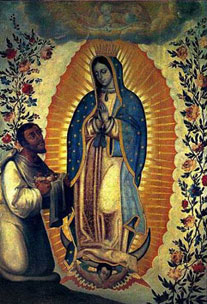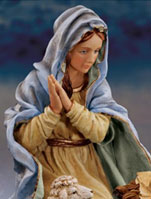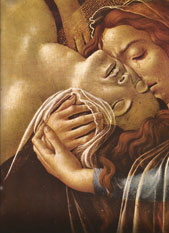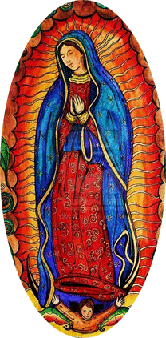
Lady of Guadalupe by Deborah Beach Giordano
History
 It is said that on the morning of December 9, 1531, a man named Juan Diego beheld the vision of a beautiful lady whom he recognized as the Virgin Mary. Speaking in his native language, the Lady asked that a church be built there in her honor — as was, in time, done. The town that eventually grew up around the hill is known as Villa de Guadalupe.
It is said that on the morning of December 9, 1531, a man named Juan Diego beheld the vision of a beautiful lady whom he recognized as the Virgin Mary. Speaking in his native language, the Lady asked that a church be built there in her honor — as was, in time, done. The town that eventually grew up around the hill is known as Villa de Guadalupe.
That is the story of the Virgin of Guadalupe, Queen of Mexico, Mother of Compassion, Patroness of the Americas, the Little Brown Virgin: a lady of many titles and a long history.
Because she appeared to a native peasant — and not to a priest or member of the elite — the Virgin of Guadalupe is understood to be a special friend of God’s people. Because she spoke to Juan Diego in his native language, the Compassionate Lady is believed to have particular concern and care for those who are “outsiders.”
Distance and Difference
I’ve written before about how this a cradle Protestant feels when it comes to the Blessed Mother of our Lord: envious. All of my Catholic friends are on friendly, familial terms with this Lady — whereas she and I are on a more formal basis.
It is the difference between plunking down comfortably on your grandmother’s sofa and meeting a grand Duchess for tea at the Ritz-Carleton. I’m in awe and hardly know what to say, whereas my friends come up and give her a great big hug.
There are times when I feel a greater longing for that warm and cozy relationship, and Advent is certainly one of them. It is not merely the desire for a “gramma” in my life, but a degree of sadness and regret that this Wonderful Woman does not receive the attention and respect she deserves.
And we miss out, too.
Fifteen Minutes of Fame
 At Christmastime Mary gets some attention — as otherwise no Baby could be born! But once the Magi arrive, Jesus’ mother gets shoved out the door. Or back into the box with the tinsel and ornaments, to be more precise.
At Christmastime Mary gets some attention — as otherwise no Baby could be born! But once the Magi arrive, Jesus’ mother gets shoved out the door. Or back into the box with the tinsel and ornaments, to be more precise.
Wherever she may go, the fact is that, by mid-January, the blessed Lady disappears. She may make a brief appearance when the boy Jesus gets separated from the family (Luke 2:41-52) or later on when his preaching seems to be leading him into danger (Mark 3:31-35) — but aside from a couple of cameos, Mary disappears entirely from our Lord’s story.
Embodied Faith
Does anyone honestly believe that Jesus’ mom has so little to do with the Gospel? This is the woman who carried the holy Infant in her womb for nine months, who fed him, bathed him, played peek-a-boo with him, taught him his prayers, and sang him lullabies. This is the woman who prayed for him, and worried about him as mothers always do. This is the woman who wept for him, and stayed with him — as dear precious Mary stood, joined by only two others, and kept watch as Jesus died on the cross.
 It is true that “Greater love hath no man than this, to lay down his life for his friends” (John 15:13), but it takes astonishing strength and grace to stand alongside a loved one as he dies. Our Lord’s mother did not faint or fail, but gave fully of her love and compassion, nurturing her Son throughout all his suffering and the pain. She did not turn away, but stayed to the end.
It is true that “Greater love hath no man than this, to lay down his life for his friends” (John 15:13), but it takes astonishing strength and grace to stand alongside a loved one as he dies. Our Lord’s mother did not faint or fail, but gave fully of her love and compassion, nurturing her Son throughout all his suffering and the pain. She did not turn away, but stayed to the end.
That’s a real embodiment of the Gospel: a life of courage and faith. That’s real strength and compassion and love. That’s a Lady I want to get to know.
That’s the lady who appeared to Juan Diego there on a hilltop in Mexico.
Return to Guadalupe

Like her holy Son, the Lady of Guadalupe makes herself available to the “regular folks:” to farmers and fieldworkers, housewives and innkeepers, potters and seamstresses and street sweepers. The rich and powerful could make no special claim on her, but often “went away empty.” Like Jesus, his blessed Mother is, first and foremost, of the people — and for the people; walking alongside the weak, the ill, and all those in need. Like her son, Little Mary of Mexico is a real shirtsleeves manager, working with and for the people of God.
That’s true Christianity, true courage, true faith. That is a powerful example of how all Christians ought to be.
The blessed Mother of our Lord is not a holiday accessory, she is not a minor player in the Gospel, but an integral part of the Jesus story — and an important character in our life of faith. She is someone we all deserve to get to know better.
Virtual hugs and real-time blessings,
Deborah †
Suggested Spiritual Exercise
How might Mary’s life of faith inform your own?